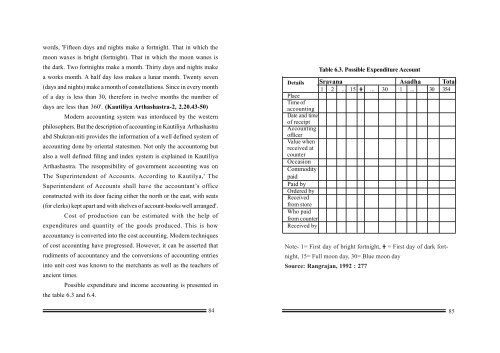Economics of Kautiliya Shukra and Brihaspati.pmd
Economics of Kautiliya Shukra and Brihaspati.pmd
Economics of Kautiliya Shukra and Brihaspati.pmd
You also want an ePaper? Increase the reach of your titles
YUMPU automatically turns print PDFs into web optimized ePapers that Google loves.
words, 'Fifteen days <strong>and</strong> nights make a fortnight. That in which the<br />
moon waxes is bright (fortnight). That in which the moon wanes is<br />
the dark. Two fortnights make a month. Thirty days <strong>and</strong> nights make<br />
a works month. A half day less makes a lunar month. Twenty seven<br />
(days <strong>and</strong> nights) make a month <strong>of</strong> constellations. Since in every month<br />
<strong>of</strong> a day is less than 30, therefore in twelve months the number <strong>of</strong><br />
days are less than 360'. (<strong>Kautiliya</strong> Arthashastra-2, 2.20.43-50)<br />
Modern accounting system was intorduced by the western<br />
philosophers. But the description <strong>of</strong> accounting in <strong>Kautiliya</strong> Arthashastra<br />
abd <strong>Shukra</strong>n-niti provides the information <strong>of</strong> a well defined system <strong>of</strong><br />
accounting done by oriental statesmen. Not only the accountomg but<br />
also a well defined filing <strong>and</strong> index system is explained in <strong>Kautiliya</strong><br />
Arthashastra. The resopnsibility <strong>of</strong> government accounting was on<br />
The Superintendent <strong>of</strong> Accounts. According to Kautilya,' The<br />
Superintendent <strong>of</strong> Accounts shall have the accountant’s <strong>of</strong>fice<br />
constructed with its door facing either the north or the east, with seats<br />
(for clerks) kept apart <strong>and</strong> with shelves <strong>of</strong> account-books well arranged'.<br />
Cost <strong>of</strong> production can be estimated with the help <strong>of</strong><br />
expenditures <strong>and</strong> quantity <strong>of</strong> the goods produced. This is how<br />
accountancy is converted into the cost accounting. Modern techniques<br />
<strong>of</strong> cost accounting have progressed. However, it can be asserted that<br />
rudiments <strong>of</strong> accountancy <strong>and</strong> the conversions <strong>of</strong> accounting entries<br />
into unit cost was known to the merchants as well as the teachers <strong>of</strong><br />
ancient times.<br />
Possible expenditure <strong>and</strong> income accounting is presented in<br />
the table 6.3 <strong>and</strong> 6.4.<br />
84<br />
Table 6.3. Possible Expenditure Account<br />
Details Sravana Asadha Total<br />
1 2 ... 15 1 ... 30 1 ... 30 354<br />
Place<br />
Time <strong>of</strong><br />
accounting<br />
Date <strong>and</strong> time<br />
<strong>of</strong> receipt<br />
Accounting<br />
<strong>of</strong>ficer<br />
Value when<br />
received at<br />
counter<br />
Occasion<br />
Commodity<br />
paid<br />
Paid by<br />
Ordered by<br />
Received<br />
from store<br />
Who paid<br />
from counter<br />
Received by<br />
Note- 1= First day <strong>of</strong> bright fortnight, 1 = First day <strong>of</strong> dark fortnight,<br />
15= Full moon day, 30= Blue moon day<br />
Source: Rangrajan, 1992 : 277<br />
85


